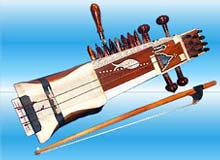 Sitar
SitarSitar is of the most popular music instruments of North India. The Sitar has a long neck with twenty metal frets and six to seven main cords. Below the frets of Sitar are thirteen sympathetic strings which are tuned to the notes of the Raga. A gourd, which acts as a resonator for the strings is at the lower end of the neck of the Sitar. The frets are moved up and down to adjust the notes. Some famous Sitar players are Ustad Vilayat Khan, Pt. Ravishankar, Ustad Imrat Khan, Ustad Abdul Halim Zaffar Khan, Ustad Rais Khan and Pt Debu Chowdhury.
Sarod
Sarod has a small wooden body covered with skin and a fingerboard that is covered with steel. Sarod does not have a fret and has twenty-five strings of which fifteen are sympathetic strings. A metal gourd acts as a resonator. The strings are plucked with a triangular plectrum. Some notable exponents of Sarod are Ustad Ali Akbar Khan, Ustad Amjad Ali Khan, Pt. Buddhadev Das Gupta, Zarin Daruwalla and Brij Narayan.
Sarangi
Sarangi is one of the most popular and oldest bowed instruments in India. The body of Sarangi is hollow and made of teak wood adorned with ivory inlays. Sarangi has forty strings of which thirty seven are sympathetic. The Sarangi is held in a vertical position and played with a bow. To play the Sarangi one has to press the fingernails of the left hand against the strings. Famous Sarangi maestros are Rehman Bakhs, Pt Ram Narayan, Ghulam Sabir and Ustad Sultan Khan.
Flute
Flute is a simple cylindrical tube of uniform bore and associated with Indian music since time immemorial. Flutes vary in size. Flute is held horizontally and is inclined downwards when it is played. To produce sound or melody one has to cover the finger holes with the fingers of the left and right hand. Variations in pitch are produced by altering the effective length of the air column. Notable flute exponents are Pt Pannalal Ghosh and Pt Hari Prashad Chaurasia.
Shehnai
Shehnai is a traditional musical instrument, associated with auspicious occasions like marriages and temple processions. Shehnai is a double reed instrument with a tapering bore which progressively increases towards the lower side. The Shehnai has finger-holes to produce semi, quarter and micro-tones. Ustad Bismillah Khan is the unrivalled maestro of the Shehnai.
Tabla
The most popular musical instrument used in North India is the Tabla. The Tabla consists of a pair of drums- the Tabla and the Bayan. The Tabla is made of wood and whereas its head is made of stretched animal skin. Finer tuning of Tabla is done by striking the rim of the Tabla with a small hammer. The Bayan is the bass drum and is usually made of metal with a stretched skin head. Both drums have a black spot in the center made of manganese or iron dust.
Pakhawaj
It is believed that the Tabla was derived from Pakhawaj. Pakhawaj usually accompanies Dhrupad style of singing. Pakhawaj is a barrel-shaped drum with two heads which are made of layers of skin. The heads of Pakhawaj are expanded by leather straps which run along the sides of the body over small cylindrical wooden blocks that are used for tuning.
Harmonium
The harmonium is a traditional and popular musical instrument of India. The harmonium has a keyboard of over two and one-half octaves and works on a system of bellows. The keyboard is played with the right hand while the left hand is used to operate the bellows. Harmonium is more popular in North India than in the South.
Jaltarangam
Jaltarangam consists of a set of eighteen porcelain cups of varying sizes. The cups are arranged in a semi-circle before the performer, in decreasing order of size. The largest cup is to the left of the performer whereas the smallest to his right. Water is poured into the cups and the pitch is changed by adjusting the amount of water in the cup. The cups are struck with two thin bamboo sticks.
Mridangam
The mridangam is one of the most popular classical instruments of South India. Mridangam accompanies vocal, instrumental and dance performances. The present day mridangam is made of a single block of wood. It is a barrel-shaped double-headed drum, the right head being smaller than the left. The two heads are made of layers of skin. The mridangam is played with hands, palms and fingers.
Ghatam
The Ghatam is one oldest percussion instruments of South India. The Ghatam is a mud pan with a narrow mouth. From its mouth, it slopes outwards to form a ridge. Ghatam is made mainly of clay baked with brass or copper filings with a small amount of iron filings. The Ghatam produces fast rhythmic patterns. Ghatam is generally a secondary percussion instrument accompanying mridangam.
No comments:
Post a Comment